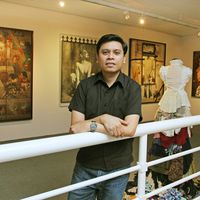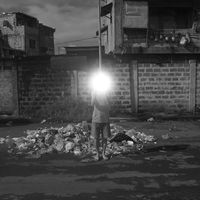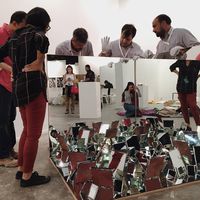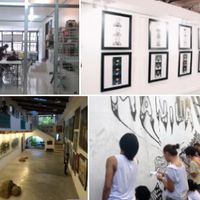A shared vision from studio to stage | Opera as collaboration

Gabriel Barredo’s “Opera,” Choreographed by Redha is a show fusing dance and the visual arts. Staged in Manila last February 2016, it was a landmark production made possible by a strong collaboration between Ballet Philippines, artist Gabriel Barredo and contemporary art gallery, Silverlens. This article aims to discuss the collaborators’ shared vision and examine ways of measuring the project’s successes.
[caption id="attachment_58628" align="aligncenter" width="620"]
 Gabriel Barredo’s “Opera,” Choreographed by Redha. Photo courtesy Jojo Mamangun.[/caption]
Gabriel Barredo’s “Opera,” Choreographed by Redha. Photo courtesy Jojo Mamangun.[/caption]Last February 2016, Gabriel Barredo’s “Opera,” Choreographed by Redha, ran for three nights at the Cultural Center of the Philippines (CCP) in Manila. It was an impressive show fusing dance and visual arts co-produced by Ballet Philippines and Silverlens Galleries, in cooperation with the French Embassy of the Philippines.
Opera was born as an art exhibition and was first presented at Silverlens in Manila (without the dance element) last January 2015, to the bemusement of the local art crowd. Grappling with themes on life, death and the suffering in between, it involved site-specific installations, kinetic sculptures, and film and sound elements. Such is the style of Gabriel Barredo, an established Manila-based artist most known for his intricate, moving works. Later on in the year, a second iteration of Opera was presented at Helutrans in Singapore by the same gallery, yet again piquing the interest and curiosity of the audiences. It was Opera’s theatrical quality that captured the interest of Ballet Philippines when they proposed to do a third iteration, this time injecting the element of dance and presenting it on a stage.
Opera’s third iteration was primarily a collaboration among Gabriel Barredo, Ballet Philippines, Silverlens, and later on the French Embassy. Although each party generally has its own interest, agenda, and stakeholders to protect, they shared a vision and common goals for Opera. This article aims to discuss this shared vision and examine ways of measuring the project’s achievements.
It is important to keep in mind that while Opera was an artistic collaboration further developed by French choreographer Redha Benteifour, musician Malek Lopez, and writers Erwin Romulo and Yvette Tan, this article is focused more on collaboration from an inter-organisational perspective. Most of the information comes from observations, conversations with the collaborators, and other materials that the author had access to, having participated in the project’s planning phase through Silverlens.
According to Ballet Philippines (BP), a privately-run organisation founded in 1969, Opera was “part of our mission to create new things and challenge the idea of what is dance per se -- how it can interact with a major installation, what will the changes be” (BP Artistic Director, Paul Morales). Opera was also part of BP’s efforts to attract new audiences and raise funds for the company.
For Silverlens, a Manila-based contemporary art gallery, Opera was another opportunity to showcase its artist, Gabriel Barredo, and reaffirm his practice of immersive art-making. It was also an effective platform for the gallery to connect with art collectors from the Philippines and the Southeast Asian region, and potentially make sales. Additionally, being co-producer of such an ambitious project, Opera was a good way to further build the gallery’s name as an ambassador of culture.
For Gabriel Barredo, Opera was a chance to translate a body of work into an original production and present it an established institution like the Cultural Center of the Philippines. This had been a long-time dream of Barredo’s and the concept thoroughly complemented his art. The artist’s practice had always been influenced by performance, as reflected by moving parts, dramatic audio-visual accompaniment, and dynamic representations of the human body in his works.
The French Embassy of Manila, who came on board at a later point, helped promote the show through their network and support French choreographer, Benteifour. While the organisation was not as involved with the production’s major decision-making, it was reasonable for them to join the project considering their interests in cultural relations and artistic exchange.
Creating a shared vision, making the right decisions
Together, the collaborators shared a bigger vision - to produce a landmark show at the Cultural Center of the Philippines that would bring together artistic practices and creative communities. By teaming up, each party was able to provide resources that the other did not possess (and vice versa). For example, Ballet Philippines, being a resident company of the Cultural Center of the Philippines, had access to the venue, while Silverlens and Barredo’s art assistants, with their expertise in mounting exhibitions, took charge of the works’ installation (among others). Naturally, the project needed a strong artistic vision that would trigger the dance, such as Barredo's and Benteifour’s.
Without the expertise and relevant resources offered by its organisers, Opera would not have been the landmark show that it came to be. After all, a collaboration “establishes a give and take among the stakeholders that is designed to produce solutions that none of them working independently could achieve” (Gray, 1989). Choosing the right partners to team up with is a strategic move for any alliance.
Another way to demonstrate Opera’s success is through its attempts at creative innovation. Although BP has had collaborations with visual artists in the past, i.e. with Philippine National Artist Benedicto Cabrera who created pieces for a set design, Opera was about being inspired by an existing work and translating it to a spectacle of dance, music, set design, and storytelling. “It’s a whole process of creation that everyone is very excited about,” says choreographer Benteifour. “I think it’s a high level of Filipino production with people who are the best in their fields.”
During its three-day run, Opera created a ‘happening’ at the CCP that local audiences and visitors would rarely experience. One way of demonstrating this is through audience reviews. From a national daily: “Dance lovers were not ready for the kind of reaction the new piece would elicit, but in the end, you saw a production that dwarfed all other artistic outputs of the season…The Barredo art installation was a work of genius by itself, and the Redha choreography transported it into the realm of dance.” Another review from a blogger: “...it is a spell-binding collage of different art forms...I am still [at a loss] for words.” After each show, spectators were also invited to the stage in order to view the performance space and interact with Barredo’s artworks more intimately.
[caption id="attachment_58629" align="aligncenter" width="620"]
 Spectators were invited to come up on stage after each performance. Photo courtesy Lai del Rosario[/caption]
Spectators were invited to come up on stage after each performance. Photo courtesy Lai del Rosario[/caption]Another way to look at Opera as a landmark show is how it inspired further collaboration. Photographers, musicians and filmmakers volunteered to be part of the production so that they could contribute to its artistic content. Thanks to their input, Opera was able to feature a live band and video mapping projections on stage, as well as produce derivative artworks that were sold as souvenirs.
Moving forward
Opera is a good example of how an ambitious project becomes possible when artists and organisations are able to team up with the right partners and align their goals. Its success is ultimately seen in how it brought together creative communities and their audiences.
In an environment like the Philippines where governmental and institutional support for culture is underdeveloped and not always easy to obtain, a shared vision and strong partnership are vital.
Apart from examining a project’s successes based on its vision, a collaboration can also be evaluated through other means. Was the schedule maintained? Did we raise the necessary funding? Was leadership among team members effective? Would we do it again? These are just some of the questions that Ballet Philippines, Silverlens, the French Embassy, and Gabriel Barredo may want to discuss moving forward. As of publication of this article, there have been talks of re-staging Opera and bringing it onto an international platform.
--
Further reading
Lai del ROSARIO is an art manager and freelance writer with a keen interest in cross-cultural creative collaborations, having lived and worked in Switzerland, France, and the Philippines. She is also currently developing an online platform that promotes creative spaces in cities.






